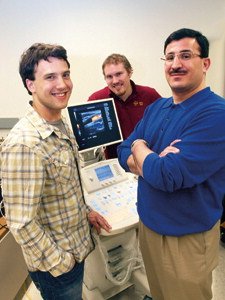CSE research leads to startup company that aims to treat artery condition with noninvasive method

Contacts: John Merritt, Office of the VP for Research, merri205@umn.edu, (612) 624-2609
Patty Mattern, University News Service, mattern@umn.edu, (612) 624-2801
Rhonda Zurn, College of Science and Engineering, rzurn@umn.edu, (612) 626-7959
MINNEAPOLIS / ST. PAUL (03/23/2011) —The University of Minnesota has finalized a license agreement with International Cardio Corporation (ICC), a Minnesota startup company, for a technology that could treat atherosclerosis, in a noninvasive manner that is faster, more precise and safer for the patient. The technology was developed by a team of researchers led by Emad Ebbini, an electrical and computer engineering professor in the College of Science and Engineering.
Atherosclerosis is a condition in which arteries become blocked and inelastic due to plaque buildup on the artery walls. These plaques can restrict blood flow or detach from the artery wall to form blood clots. The condition can be treated with drugs, or the patient can undergo an angioplasty -- a procedure in which the arteries are inflated using a small balloon.
Donald Knight, president of ICC, has a brother who nearly died during an angioplasty procedure.
"Angioplasty is an effective procedure, but it carries risks," Knight said. As a result of that experience, he began thinking about alternatives to the procedure. "My goal is to develop a noninvasive alternative to angioplasty," he said.
The University research team led by Ebbini developed high-intensity focused ultrasound (HIFU) technology that performs noninvasive, real-time ultrasonic imaging and localized treatment of tissue abnormalities (cancer tumors, fibroids, etc.). The technology can also be applied in the treatment of vascular disease.
HIFU is a form of nonionizing radiation, suitable for localizing treatment to small areas, comparable to a grain of rice or sesame seed. Current systems, under MRI or ultrasound guidance, deliver therapeutic HIFU shots at 2 to 5 second intervals with little or no feedback control while the energy is being applied. The university-developed system images tissue response to the HIFU beam at intervals less than 10 milliseconds apart. These dynamic images serve as feedback for refocusing the energy at the target. Ebbini describes the dual abilities of HIFU technology by comparing the single HIFU shot to firing a bullet.
"They shoot, and then they see what happens, whether they have hit the target correctly, or hit something else that should not have been hit," said Ebbini, referring to existing systems under MRI or ultrasound image guidance. "It's usually too late by then. In our case, we monitor that bullet with millisecond resolution, as the lesion is being formed, and we will be able to make the necessary adjustments to the HIFU exposure to optimize the treatment outcome for every HIFU shot in real time."
Because HIFU equipment is less expensive than other imaging techniques, such as MRI, the procedure could be more accessible to doctors and less expensive for patients. Ebbini's technology also has the unique ability to tightly link imaging and therapy, meaning it would be more efficient and precise than MRI or other ultrasound guidance technologies.
"Other people currently use ultrasound to treat abnormal tissues in the body," said Dale Nugent, marketing manager for the university's Office for Technology Commercialization. "But what they will do is take a picture with an ultrasound system and treat after a significant delay.This is repeated many times. Ebbini's approach allows you to image the tissue of concern, heat it, and sense the temperature simultaneously, so you can interactively monitor and control the levels of the treatment and its safety. It's a procedure that requires a lot of iteration so this closed loop approach greatly reduces treatment time. It's also great for getting the exact amount of ultrasonic energy the doctor wants delivered to the treatment site. No more, no less."
HIFU is also safer than invasive surgery or other forms of radiation therapy.
"This would be safer than anything you can think of," said Ebbini. "For HIFU, we use higher intensity levels to achieve the desired therapeutic effect. The advantage of our approach is that therapeutic exposure is confined to the focal spot without collateral damage to the intervening normal tissues."
Ebbini anticipates applications for HIFU beyond treatment of atherosclerosis.
"The applications are almost limitless, but the obvious ones are in the treatment of cancer," he said. "Our dual-mode ultrasound array technology is especially suited to targets in the abdominal region, like kidney, liver or pancreatic cancers, most of them are inoperable. While our goal would be complete eradication of tumors, this technology may provide cost-effective palliative options for some patients. Other patients may benefit by downgrading their tumors to fall back in the operable range. There is so much good that can be accomplished with this technology."
International Cardio Corporation hopes to submit to FDA testing later this year. Knight is also open to exploring other applications for HIFU.
Ebbini's research, which takes place at the Ultrasound Imaging and Signal Processing Laboratory (UISPL), was funded by the National Science Foundation, the National Institutes of Health, the ARMY's Congressionally Directed Medical Research Program (CDMRP) and International Cardio Corporation.
